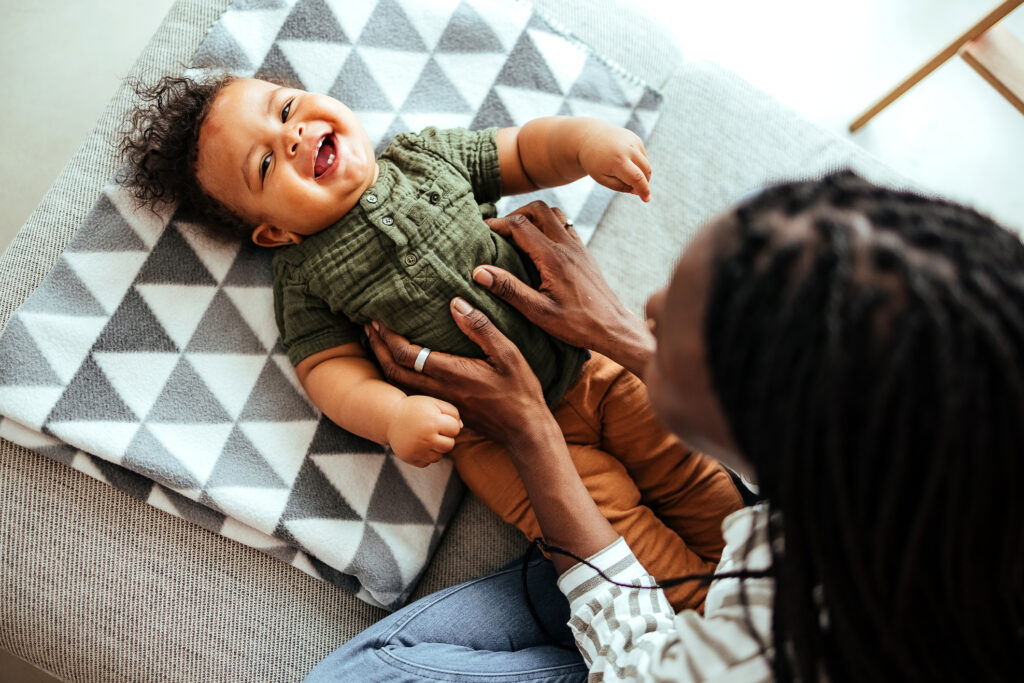At seven months old, your baby is learning new skills every day – and it can feel both exciting and a little amazing. Understanding the most common 7-month-old milestones helps you track progress, celebrate achievements, and know when to ask questions. While every baby develops at their own pace, there are typical milestones for 7-month-old babies that can serve as helpful benchmarks.
In this article, we’ll walk you through the major developmental milestones for a 7-month-old, how you can support them, and when to reach out if something feels off.
Typical Milestones for a 7-Month-Old Baby
Here’s a quick overview of the milestones of a 7-month-old across developmental areas, along with tips on how to support your baby:
| Developmental Area | Typical 7 Month Old Milestones | What You Can Do to Support |
| Motor Skills | Sits briefly without support (progressing to sitting steadily); rolls both ways; rocks on hands and knees (some may scoot or crawl) | Encourage tummy time; let baby play safely on the floor |
| Language | Babbles using sounds like “ba” or “da”; responds to tone of voice | Talk and sing to baby; repeat their sounds back to them |
| Cognitive | Explores with hands and mouth; begins noticing partially hidden objects | Play hide-and-seek games with toys; offer toys of various textures |
| Social/Emotional | Smiles at familiar people; may show stranger anxiety | Maintain consistent routines and offer comfort |
| Vision and Hearing | Recognizes faces; follows moving objects; turns toward sounds and voices | Use colorful toys and talk from different directions |
🍼 Note: Some 7-month-olds may not crawl yet, and that’s completely normal. Babies reach milestones in different orders and at different times.
Key 7-Month-Old Developmental Milestones
1. Sitting Without Support
Many babies begin to sit up for a few seconds by themselves around this time. As they gain more strength and balance, they may sit steadily for longer.
Support Tip: Practice on a soft surface with toys nearby to build balance.
2. Babbling and Early Language
Your baby may now experiment with sounds like “ba-ba” or “da-da.” While these aren’t words yet, they’re a key part of early speech development.
Support Tip: Talk to your baby throughout the day, especially during routines like diaper changes and feeding.
3. Exploring the World Through Play
At seven months, babies love exploring objects with their hands and mouths. They may begin looking for toys that are only partially hidden, showing the early signs of object permanence.
Support Tip: Hide a toy under a cloth and encourage your baby to find it.
4. Social and Emotional Growth
You might notice your baby becoming more attached to caregivers and wary of strangers. These are healthy emotional responses.
Support Tip: Offer plenty of smiles, cuddles, and reassurance.
5. Starting to Move
Some babies begin scooting or rolling to get around, while others may rock back and forth on hands and knees.
Support Tip: Create a babyproofed area where your child can safely explore.
When to Be Concerned
While developmental timelines vary, persistent signs of delay could signal a need for further assessment. Speak with your pediatrician if your baby:
- Doesn’t make eye contact or smile back at familiar people
- Has very stiff or very floppy muscle tone
- Doesn’t reach for toys or bring hands to mouth
- Shows little or no interest in people, voices, or surroundings
⚠️ Tip: These concerns should be observed consistently over days or weeks, not just in a single moment.
Supporting Your Baby’s Development at Home
- Practice floor time and tummy time daily.
- Talk, sing, and read to your baby regularly.
- Offer age-appropriate toys that encourage grasping and mouthing.
- Keep a predictable routine to provide a sense of security.
- Babyproof your home so your baby can safely explore new movements.
Frequently Asked Questions
- What should a 7-month-old be doing developmentally?
Most 7-month-olds can sit briefly without help, babble using repeated sounds, reach for objects, and recognize familiar faces.
2. What motor skills should a 7-month-old have?
They usually roll both ways, sit up for short periods, and may begin scooting or crawling. Some babies also rock on their hands and knees.
3. What are the red flags at 7 months?
Red flags may include no smiling, no eye contact, no response to sounds, or muscle stiffness/floppiness. If these signs persist, consult your pediatrician.
4. Is it normal for a 7-month-old to not crawl?
Yes. Not all babies crawl at 7 months. Some skip crawling entirely and go straight to pulling up or walking.
5. How can I help my 7-month-old meet milestones?
Provide floor time, talk often, read books, respond to cues, and create a safe space for movement and exploration.
Tracking 7-month-old milestones can help you celebrate progress while staying alert to any signs that may require extra attention. If you’re concerned about your baby’s development, don’t hesitate to reach out to a healthcare provider – early support can make a lasting difference.
Want a quick, free way to see if your baby’s development is on track? Try using an at-home developmental screening tool designed for families. It can help you identify strengths, notice any potential delays, and feel more confident about your child’s growth journey.
Every baby is unique. Keep encouraging, engaging, and enjoying this exciting stage of development.



